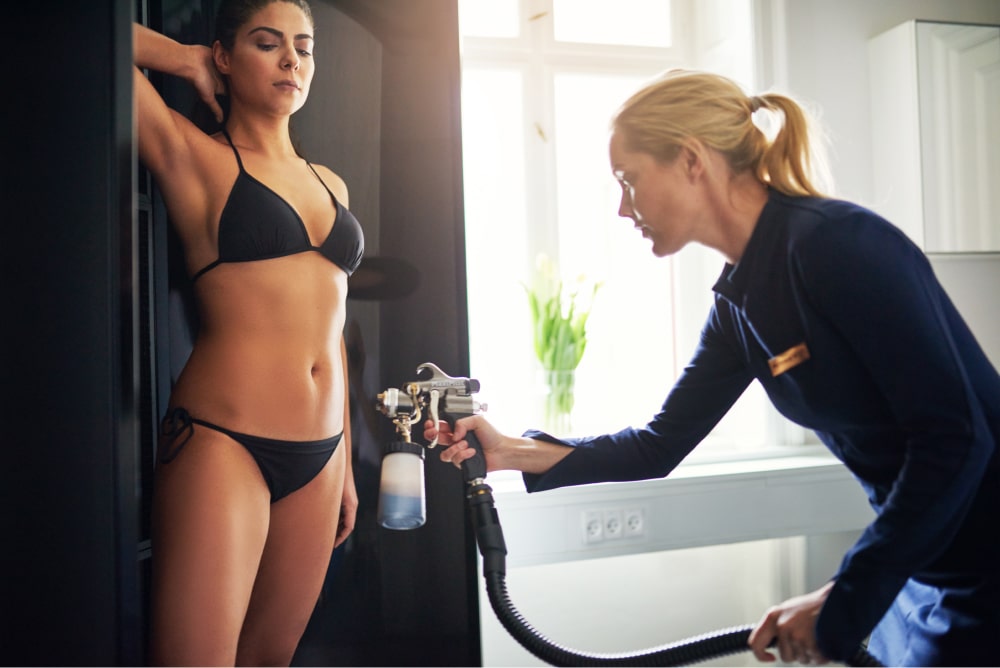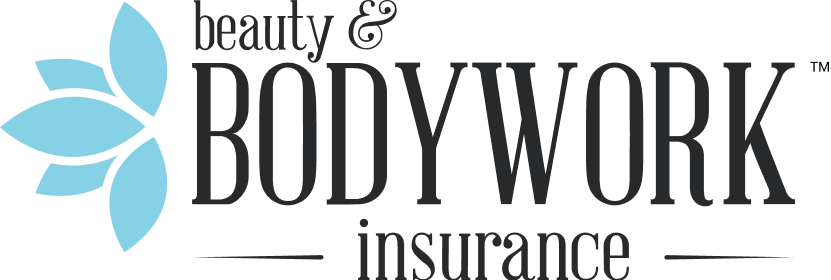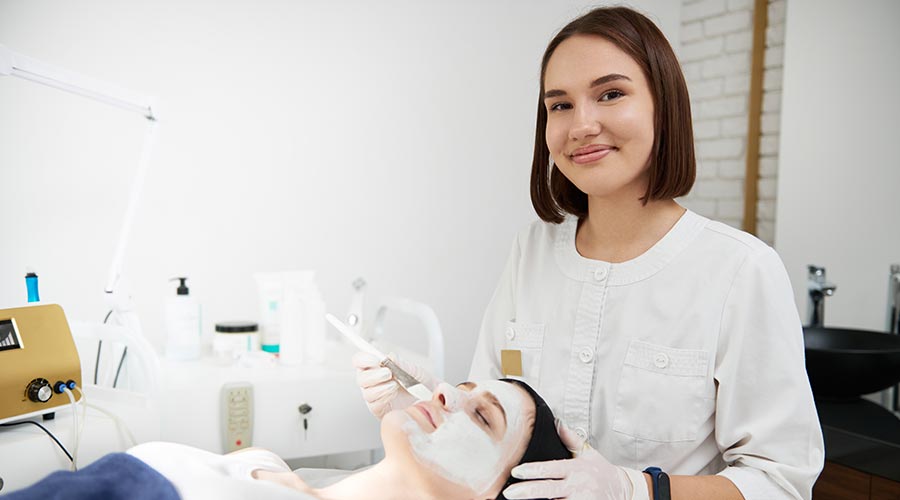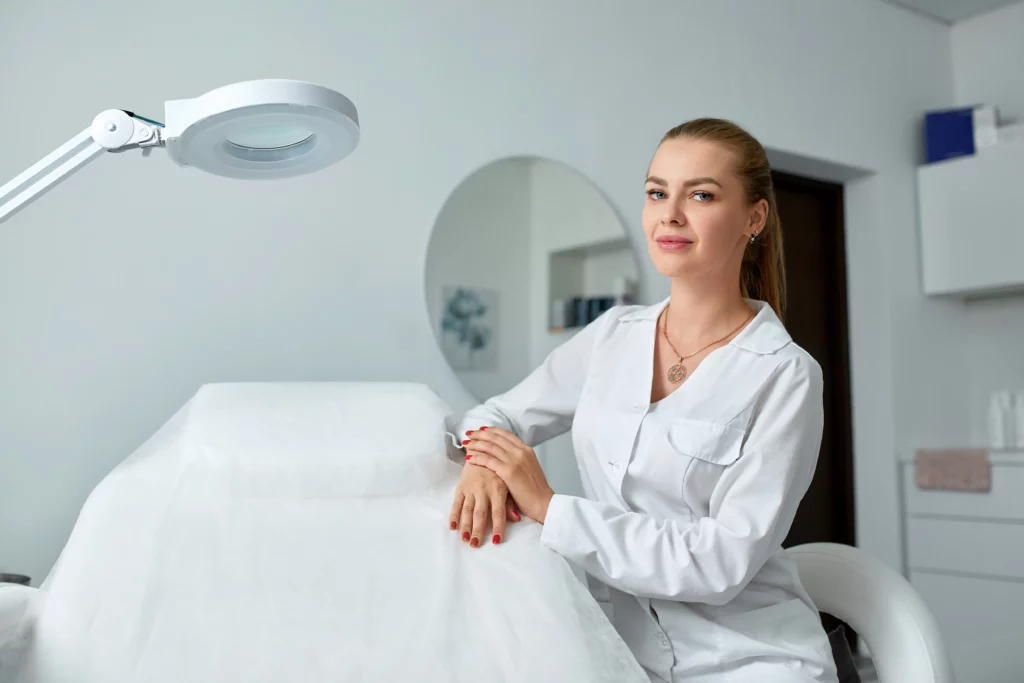Skin-esteem is self-esteem! 60% say their skin impacts their self-esteem, and 58% say that bad skin has caused them social anxiety in the past, according to a Mederma study. This is where finding a great esthetician can make all the difference. Estheticians are to skincare what hairdressers are for your hair—knowledgeable professionals dedicated to helping you get the best results!
That’s exactly what Bethany George, writer for Shape Magazine, hoped to find when she was preparing for her wedding day and reached out to an esthetician to help treat the “pimple factory” on her nose and chin. Her eye-opening first appointment helped her realize that the grab bag full of products she used every day might have actually been making her skin worse.
“I’m not going to lie, after learning all of these tips, I felt embarrassed — but also relieved that I was in good hands. I had no idea how much I’d been, dare I say, tricked into buying products due to savvy advertising and trendy marketing,” she wrote.
Estheticians are skincare experts who specialize in various skin treatments and beauty services, and a good one can help your complexion glow like never before. They provide cosmetic treatments like facials, skincare analysis, hair removal, and other services to enhance the appearance and health of the skin. And, like in Bethany’s case, they can also educate clients on proper skin care practices and recommend products to maintain skin health.
Keep reading to find out what you’ll need to do if you want to become an esthetician, how much they make, and the types of services they provide.
Where do Estheticians Work?
The huge variety of treatments estheticians can offer translates to an equally expansive number of workplaces where they can provide their services. Some of the most common include:
- Spas: Spas allow estheticians to provide services in tandem with other beauty and bodyworkers in a relaxing environment.
- Salons: Salons typically offer services in a more casual setting than a spa, but contain all of the space and supplies estheticians need to perform their services.
- Medical offices/med spas: Medical professionals often hire estheticians to perform treatments within their practices with the intent of offering a comprehensive list of services, including medical-grade ones.
However, estheticians have more career options available than immediately going into practice. Some can also translate their skills and knowledge to related fields like teaching, or even sales and marketing.
For example, estheticians with advanced certifications can choose to teach those services in cosmetology schools. Alternatively, cosmetic lines, skincare brands, and other beauty industry companies often choose to hire estheticians to work in sales or marketing due to their first-hand experience with client interactions and product knowledge.
What Does It Take to Become an Esthetician?
Becoming an esthetician requires that you take a formal training program at a beauty school or cosmetology institute. These programs cover a variety of topics in both theoretical and practical ways. Some of the coursework an esthetician might cover in cosmetology school includes:
- Anatomy and physiology of skin cells and tissue
- Color theory and the basics of makeup application to create looks for different occasions and skin types.
- Basic biochemistry in order to better understand how compounds in different products can interact with skin pH levels, aggravate sensitivity, and more.
- Sanitation in order to control infection and minimize the spread of bacteria.
After completing your training, you’ll then need to pass a licensing exam to become a certified esthetician. Licensing requirements vary by state and usually include both a written exam and a practical skills assessment.
For example, in the United States, estheticians need to complete a certain number of training hours (ranging from 600 to 1,500 hours depending on the state) before being eligible to take the licensing exam. The difference in required hours between states can come down to a few different factors including:
- Keeping services competitive by ensuring that estheticians from other states don’t reap the reward with fewer training hours.
- Accounting for consumer demand by ensuring that estheticians train longer to provide superior services in high-demand markets.
- Simple differences in legislation influenced by the state’s cosmetology board and the standards they approve.
Once licensed, some estheticians might be required to renew their licenses periodically by completing continuing education (CE) courses. Your state’s regulations will usually list these requirements.
Before seeing your first client, you’ll also need to get an esthetician liability insurance policy in place. It can protect you and your business in the event that:
- A client brings a claim of bodily injury against you
- In the case of property damage (like if you damage something in a space you’ve rented)
- A client sues you because of advice you gave them (or failed to give them)
- You inadvertently use someone’s pictures without permission
- And more

What Services Do They Provide?
US Bureau of Labor Statistics data shows that there are more than 60,000 estheticians in the U.S. These tens of thousands of estheticians help their clients look and feel their best through personalized skincare treatments like:
Facials
During a facial treatment, estheticians typically start by analyzing their client’s skin and cleansing it to remove any impurities and makeup. Then, the esthetician may exfoliate the skin to remove dead cells, followed by steaming to open up pores.
They might also perform extractions if needed to clear out any blackheads or whiteheads. Finally, they often finish with a massage to relax the client and improve circulation, followed by masks or serums tailored to the client’s skin concerns and moisturizers to hydrate and protect.
Extractions
Extractions are done to remove any blackheads or whiteheads (trapped oil and bacteria clogging the pores of the face). Estheticians use tools like comedone extractors to gently remove blackheads, and then apply soothing products to the skin to calm any redness or irritation. It’s important for estheticians to be skilled and gentle during this process to avoid causing any damage to the skin.
Acne Treatment
When it comes to treating acne, estheticians aim to reduce inflammation, unclog pores, and promote clearer skin through a variety of treatments. They can also provide advice on improving skincare routines and lifestyle choices to help manage acne breakouts.
Your esthetician might start by analyzing your skin and asking you some questions to help establish the root cause of your acne, then using a combination of facials, chemical peels, extractions, and exfoliators based on the severity and type of acne you’re experiencing.
Microdermabrasion
During a microdermabrasion treatment, a device is used to spray very fine crystals into the skin to exfoliate and remove the outer layer of dead skin cells on your face. This helps to reveal smoother, fresher skin underneath and can improve the appearance of fine lines, wrinkles, acne scars, and sun damage.
Chemical Peels
During a chemical peel treatment, a chemical solution is applied to the skin to exfoliate and peel off the top layers. This helps improve skin texture, remove dead skin cells, and stimulate cell turnover. The level of exfoliation depends on the type of peel used – superficial, medium, or deep.
After the treatment, the skin may appear red and feel sensitive, but this usually subsides within a few days to reveal smoother, rejuvenated skin. It’s important to follow post-treatment care instructions for optimal results and to protect your skin from sun exposure.
Brow and Lash Treatments
Estheticians typically offer a range of eyebrow and lash treatments such as eyebrow shaping (through waxing, threading, or tweezing), tinting for darker or more defined brows and lashes, lash lifts to enhance the natural curl of lashes, and eyelash extensions for a fuller, longer lash look.
Hair Removal
There are a number of common hair removal treatments, but some of the most common ones include waxing, sugaring, threading, and tweezing. Estheticians may also provide services like laser hair removal or electrolysis for more permanent results. Each method has its own benefits and considerations, so it’s best to consult with your esthetician to determine the right option for you.
Airbrush Tanning
During airbrush tanning, an esthetician uses a special spray gun to apply a sunless tanning solution to your skin. The solution contains DHA, a colorless sugar that interacts with the amino acids in the top layer of your skin to create a tan color. The esthetician will carefully spray the solution evenly over your body, making sure to cover all areas for a natural-looking tan.
Laser treatments
Estheticians can perform a variety of laser treatments. Laser hair removal targets hair follicles to reduce unwanted hair growth. Laser skin rejuvenation helps improve skin tone and texture by stimulating collagen production.
Laser acne treatments target and reduce acne-causing bacteria and inflammation. Laser vein treatments help diminish the appearance of spider veins and varicose veins. These treatments can vary in intensity and may require multiple sessions for best results.
LED light therapy
LED light therapy is a non-invasive skincare treatment where different wavelengths of light are used to target various skin concerns. When performed by an esthetician, they will typically customize the treatment based on your skin type and needs. The light energy from the LED device can help to stimulate collagen production, reduce inflammation, kill acne-causing bacteria, and improve overall skin tone and texture.

What Don’t Estheticians Do?
While estheticians learn about the basic biology and physiology behind the success of certain treatments, their skill set is limited to cosmetic procedures. In other words, if you’re suffering from any kind of medical condition, it’s best to see a dermatologist or medical doctor.
For example, estheticians can’t:
- Diagnose ailments: If you’re experiencing medical symptoms, an esthetician can’t legally give you a formal diagnosis for your condition.
- Prescribe medications: Similarly, even if you have a formal diagnosis from a dermatologist for any skin conditions, you can’t go to an esthetician for prescription-grade topical or oral medication.
- Suggest medical treatment: Estheticians are exposed to certain skin conditions throughout the course of their work, and they can provide treatment for superficial conditions like acne, rosacea, or eczema. However, chronic skin conditions and injuries (e.g., skin cancer, burns, lesions, open wounds, and so on) need to be treated by licensed medical professionals.
- Invasive procedures: Estheticians can only treat the epidermis or outermost layer of your skin. This means they can’t perform injections like botox or fillers, or remove skin growths, moles, warts, etc. These are all technically classified as medical procedures and need to be performed by someone with a valid medical license.
Building an Independent Esthetician Business
Many estheticians who specialize in a certain treatment often choose to go into independent practice. An eyelash technician, for example, can operate under their own brand name, advertise their services through social media or an independent website, and perform their services in a client’s home or in a rented space. See some related articles about how to build your business as an independent esthetician from BBI:Frequently Asked Questions
What’s the Difference Between an Aesthetician, Esthetician, and Dermatologist?
These three jobs may have similar-sounding descriptions, but there are distinct differences between them. Estheticians provide cosmetic treatments designed to improve the appearance of the skin. Aestheticians undergo a similar level of education but tend to work in clinical settings with an emphasis on medical treatment as opposed to strictly cosmetic procedures.
Dermatologists are medical doctors who specialize in working with the skin. They have 4-year medical degrees and can perform advanced medical treatments like surgeries or blood testing. They can also diagnose and treat skin conditions or diseases, as well as prescribe medication.
What’s the Average Esthetician Salary?
How Long Does it Take to Complete Esthetician Training?
Estheticians usually finish their required training hours in 8-10 months. But depending on your state’s requirements, the number of hours you spend doing hands-on training required for licensing varies significantly.





